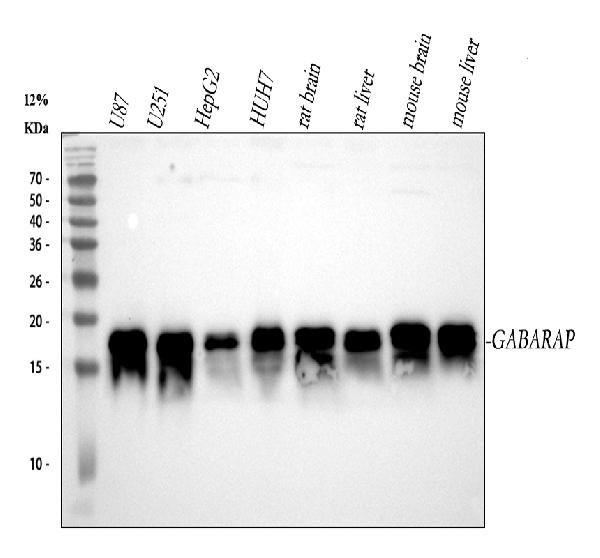Anti-GABARAP Monoclonal Antibody
- SPECIFICATION
- CITATIONS
- PROTOCOLS
- BACKGROUND

Application
| WB, IHC, IF, ICC, FC |
|---|---|
| Primary Accession | O95166 |
| Host | Rabbit |
| Isotype | Rabbit IgG |
| Reactivity | Rat, Human, Mouse |
| Clonality | Monoclonal |
| Format | Liquid |
| Description | Anti-GABARAP Monoclonal Antibody . Tested in WB, IHC, ICC/IF, Flow Cytometry applications. This antibody reacts with Human, Mouse, Rat. |
| Gene ID | 11337 |
|---|---|
| Other Names | Gamma-aminobutyric acid receptor-associated protein, GABA(A) receptor-associated protein, MM46, GABARAP (HGNC:4067), FLC3B |
| Calculated MW | 18 kDa |
| Application Details | WB 1:500-1:2000 IHC 1:100-1:500 ICC/IF 1:50-1:200 FC 1:50 |
| Contents | Rabbit IgG in phosphate buffered saline, pH 7.4, 150mM NaCl, 0.02% sodium azide and 50% glycerol, 0.4-0.5mg/ml BSA. |
| Clone Names | Clone: ACHE-7 |
| Immunogen | A synthesized peptide derived from human GABARAP GABARAP is cleaved at its carboxyl terminus, which leads to conjugation by either of the phospholipids phosphatidylethanolamine or phosphatidylserine. This processing converts GABARAP from a type I to a type II membrane bound form involved in autophagosome biogenesis. Processing of GABARAP involves cleavage by Atg4 family members followed by conjugation by the E1 and E2 like enzymes Atg7 and Atg3. |
| Purification | Affinity-chromatography |
| Storage | Store at -20°C for one year. For short term storage and frequent use, store at 4°C for up to one month. Avoid repeated freeze-thaw cycles. |
| Name | GABARAP (HGNC:4067) |
|---|---|
| Synonyms | FLC3B |
| Function | Ubiquitin-like modifier that plays a role in intracellular transport of GABA(A) receptors and its interaction with the cytoskeleton (PubMed:9892355). Involved in autophagy: while LC3s are involved in elongation of the phagophore membrane, the GABARAP/GATE-16 subfamily is essential for a later stage in autophagosome maturation (PubMed:15169837, PubMed:20562859, PubMed:22948227). Through its interaction with the reticulophagy receptor TEX264, participates in the remodeling of subdomains of the endoplasmic reticulum into autophagosomes upon nutrient stress, which then fuse with lysosomes for endoplasmic reticulum turnover (PubMed:31006538). Also required for the local activation of the CUL3(KBTBD6/7) E3 ubiquitin ligase complex, regulating ubiquitination and degradation of TIAM1, a guanyl-nucleotide exchange factor (GEF) that activates RAC1 and downstream signal transduction (PubMed:25684205). Thereby, regulates different biological processes including the organization of the cytoskeleton, cell migration and proliferation (PubMed:25684205). Involved in apoptosis (PubMed:15977068). |
| Cellular Location | Cytoplasmic vesicle, autophagosome membrane. Endomembrane system {ECO:0000250|UniProtKB:P60517}. Cytoplasm, cytoskeleton {ECO:0000250|UniProtKB:P60517}. Golgi apparatus membrane {ECO:0000250|UniProtKB:P60517}. Cytoplasmic vesicle {ECO:0000250|UniProtKB:P60517}. Note=Largely associated with intracellular membrane structures including the Golgi apparatus and postsynaptic cisternae. Colocalizes with microtubules (By similarity) Localizes also to discrete punctae along the ciliary axoneme (By similarity). {ECO:0000250|UniProtKB:P60517, ECO:0000250|UniProtKB:Q9DCD6} |
| Tissue Location | Heart, brain, placenta, liver, skeletal muscle, kidney and pancreas. |

Thousands of laboratories across the world have published research that depended on the performance of antibodies from Abcepta to advance their research. Check out links to articles that cite our products in major peer-reviewed journals, organized by research category.
info@abcepta.com, and receive a free "I Love Antibodies" mug.
Provided below are standard protocols that you may find useful for product applications.
If you have used an Abcepta product and would like to share how it has performed, please click on the "Submit Review" button and provide the requested information. Our staff will examine and post your review and contact you if needed.
If you have any additional inquiries please email technical services at tech@abcepta.com.













 Foundational characteristics of cancer include proliferation, angiogenesis, migration, evasion of apoptosis, and cellular immortality. Find key markers for these cellular processes and antibodies to detect them.
Foundational characteristics of cancer include proliferation, angiogenesis, migration, evasion of apoptosis, and cellular immortality. Find key markers for these cellular processes and antibodies to detect them. The SUMOplot™ Analysis Program predicts and scores sumoylation sites in your protein. SUMOylation is a post-translational modification involved in various cellular processes, such as nuclear-cytosolic transport, transcriptional regulation, apoptosis, protein stability, response to stress, and progression through the cell cycle.
The SUMOplot™ Analysis Program predicts and scores sumoylation sites in your protein. SUMOylation is a post-translational modification involved in various cellular processes, such as nuclear-cytosolic transport, transcriptional regulation, apoptosis, protein stability, response to stress, and progression through the cell cycle. The Autophagy Receptor Motif Plotter predicts and scores autophagy receptor binding sites in your protein. Identifying proteins connected to this pathway is critical to understanding the role of autophagy in physiological as well as pathological processes such as development, differentiation, neurodegenerative diseases, stress, infection, and cancer.
The Autophagy Receptor Motif Plotter predicts and scores autophagy receptor binding sites in your protein. Identifying proteins connected to this pathway is critical to understanding the role of autophagy in physiological as well as pathological processes such as development, differentiation, neurodegenerative diseases, stress, infection, and cancer.


